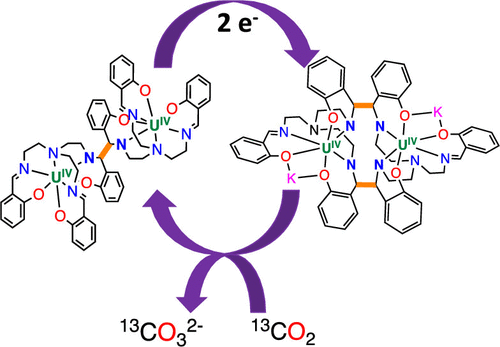当前位置:
X-MOL 学术
›
Organometallics
›
论文详情
Our official English website, www.x-mol.net, welcomes your feedback! (Note: you will need to create a separate account there.)
Carbon Dioxide Reduction by Multimetallic Uranium(IV) Complexes Supported by Redox-Active Schiff Base Ligands
Organometallics ( IF 2.8 ) Pub Date : 2020-02-27 , DOI: 10.1021/acs.organomet.9b00792 Nadir Jori 1 , Marta Falcone 1 , Rosario Scopelliti 1 , Marinella Mazzanti 1
Organometallics ( IF 2.8 ) Pub Date : 2020-02-27 , DOI: 10.1021/acs.organomet.9b00792 Nadir Jori 1 , Marta Falcone 1 , Rosario Scopelliti 1 , Marinella Mazzanti 1
Affiliation

|
The synthesis, structure, and reactivity with CO2 and CS2 of new U(IV) complexes with a redox-active Schiff base are reported. The reaction of UI3 with the heptadentate Schiff base ligand 2,2′,2″-tris(salicylideneimino)triethylamine (trensal) did not lead to the formation of a U(III) complex but to the reductive coupling and C–C bond formation between two imino groups of the Schiff base, yielding the U(IV) complex [U2(bis-trensal)], 1. Further reduction of 1 led to the dinuclear macrocyclic complex [{K(THF)3}2U2(cyclo-trensal)], 3-THF, through a second C–C bond formation reaction between two additional imino groups. Complexes 1 and 3 are oxidized by AgOTf resulting in the cleavage of the C–C bonds and leading to the formation of the U(IV) complex [U(trensal)]OTf, 2. Complex 1 does not reduce CO2 or CS2 but undergoes insertion of CO2 into one of the U–N bonds. In contrast, the reaction of 3 with 2 equiv of CO2 leads to the reductive disproportionation of CO2 to afford carbonate in 80% yield. In the presence of a large excess of CO2 multiple reactions take place, as supported by the isolation of the crystals of [{K(THF)3}U2(μ-O)(CO2–CO-cyclo-trensal)(U(trensal))], 4. The higher reductive activity toward CO2 of complex 3 compared to previously reported U(IV) complexes of reduced Schiff bases is interpreted in terms of its redox properties.
中文翻译:

氧化还原活性席夫碱配体支持的多金属铀(IV)配合物还原二氧化碳
报道了具有氧化还原活性席夫碱的新型U(IV)配合物的合成,结构和与CO 2和CS 2的反应性。UI 3与七齿Schiff碱配体2,2',2''-三(水杨亚胺基)三乙胺(trensal)的反应不会导致U(III)配合物的形成,但会导致还原偶联和C–C键在席夫碱的两个亚氨基之间形成U(IV)络合物[U 2(bis-trensal)],1。1的进一步还原导致双核大环复合物[{K(THF)3 } 2 U 2(环-trensal)],3-THF通过另外两个亚氨基之间的第二次CC键形成反应。复合物1和3被AgOTf氧化,导致C-C键断裂,并导致形成U(IV)复合物[U(trensal)] OTf,2。复杂1不减少CO 2或CS 2,但CO的经历插入2到U-N键中的一个。相比之下,反应3与2当量的CO 2导致CO的还原歧化2,得到收率80%的碳酸盐。在大量过量的CO 2存在下分离[[K(THF)3 } U 2(μ-O)(CO 2 -CO-环-trensal)(U(trensal))],4的晶体有助于发生多个反应。与以前报道的还原的席夫碱的U(IV)配合物相比,配合物3对CO 2的还原活性更高,这是因为其氧化还原特性。
更新日期:2020-02-27
中文翻译:

氧化还原活性席夫碱配体支持的多金属铀(IV)配合物还原二氧化碳
报道了具有氧化还原活性席夫碱的新型U(IV)配合物的合成,结构和与CO 2和CS 2的反应性。UI 3与七齿Schiff碱配体2,2',2''-三(水杨亚胺基)三乙胺(trensal)的反应不会导致U(III)配合物的形成,但会导致还原偶联和C–C键在席夫碱的两个亚氨基之间形成U(IV)络合物[U 2(bis-trensal)],1。1的进一步还原导致双核大环复合物[{K(THF)3 } 2 U 2(环-trensal)],3-THF通过另外两个亚氨基之间的第二次CC键形成反应。复合物1和3被AgOTf氧化,导致C-C键断裂,并导致形成U(IV)复合物[U(trensal)] OTf,2。复杂1不减少CO 2或CS 2,但CO的经历插入2到U-N键中的一个。相比之下,反应3与2当量的CO 2导致CO的还原歧化2,得到收率80%的碳酸盐。在大量过量的CO 2存在下分离[[K(THF)3 } U 2(μ-O)(CO 2 -CO-环-trensal)(U(trensal))],4的晶体有助于发生多个反应。与以前报道的还原的席夫碱的U(IV)配合物相比,配合物3对CO 2的还原活性更高,这是因为其氧化还原特性。



























 京公网安备 11010802027423号
京公网安备 11010802027423号